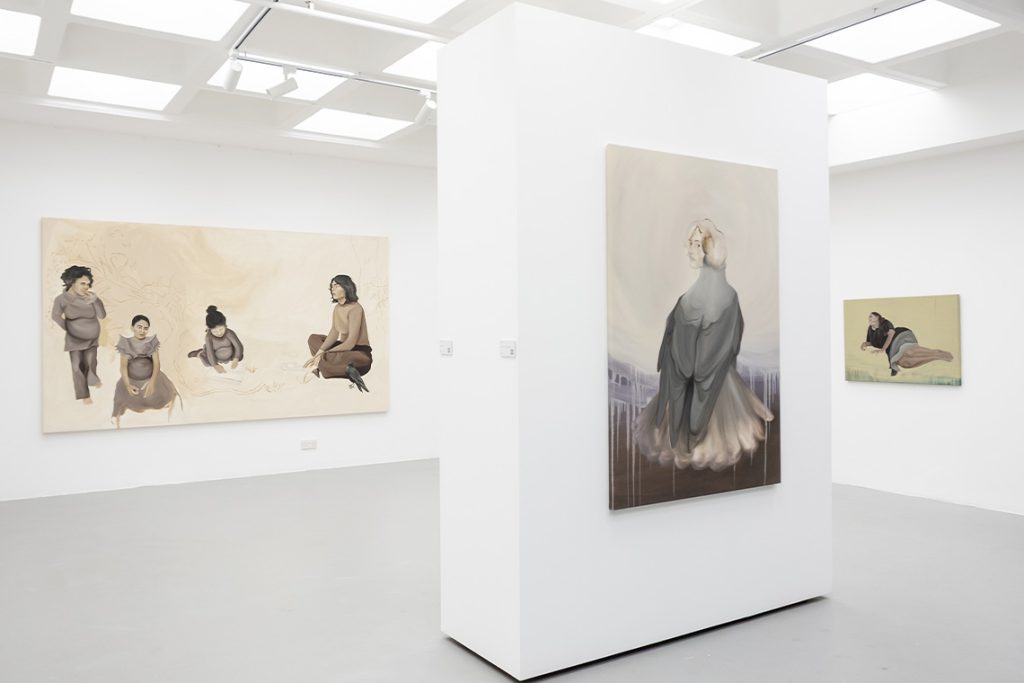Amina Yahia’s solo exhibition traces how systems of control in contemporary Egypt manifest across landscapes, how bodies adjust and exist with them, and how emotional and psychological states are shaped by them.
Currently showing at Kuwait’s Hunna Art Gallery is Amina Yahia’s show They Call Me Divine, a phrase that appears half spoken and carrying reverence and accusation in equal measure. With the implied presence of a narrator, the immediate assumption is that the many women who populate the canvases in various states of melancholy are the ones bearing this mystical imposition.
It is, however, the landscape of Cairo, where Yahia was raised, that forms the invisible protagonist of the exhibition, appearing only in allusions to atmosphere and gestures of mood. Growing up in the city, she recalls witnessing how sociopolitical transformations were manifested across the built environment, in public institutions and domestic structures alike. Even in the smallest exchanges between people, these shifts shaped not only modern Egyptian society but also the psyche of its inhabitants.
Yahia describes the result as a field of collective grief — the lingering exhaustion of a city caught between revolutions that promised renewal, and the colonial, patriarchal and class-based systems that remain intact beneath their surface. Her paintings emerge from within that historical fatigue, responding to decades of institutional neglect and pressure.

These ideas run through Can you breathe (2025). Yahia shares that the painting confronts the “slow, insidious forms of torture embedded in bureaucracy and the everyday limitations imposed by institutions”. Considering how endurance becomes a form of raw survival, despite these conditions, the work depicts a man laid across a woman’s lap as she threads his lungs back into place. Her steadied hands are absorbed in the small precision of a task that feels both medical and maternal; meanwhile, his body and expressions lay slack in contrast, withering to become one with the surroundings – an airless haze of pale umbers evoking dust and desert.
Within this, the almost meditative act of sewing also echoes the monotonous rhythms of daily life in which acts of coping have become so deeply ingrained that they almost pass for normalcy. “There is something almost spiritual in that, a cyclical, resigned acceptance that borders on the ritualistic,” the artist says.
This state of incomplete healing extends beyond concept and into the structure of the paintings themselves. Yahia’s figures are suspended in moments of partial transformation, inhabiting scenes dissolving into blurs and evoking collective displacement. Somewhat recalling the shift of Impressionism toward registering sensations of experience and emotion, her atmospheric accounts capture how people carry the weight and impacts of these unstable systems in their bodies.
Particular attention is paid to the experience of women – “the ones that bear the cumulative weight of social expectations”, says curator Alexandra Stock. In the unsettling Tell my mother (2025), a group of young girls, around ten years old, appear visibly pregnant with empty expressions in subdued grey hues. A social commentary on the very pertinent issue of child marriage in working-class and rural Egyptian communities, the work touches upon class-based indoctrination and obedience. Yahia reads this ‘sacred institution’ of marriage, inflicted upon the young girls and forcing their bodies to be torn between motherhood and childhood, as a kind of illness imposed by society. The title calls for accountability.

Redolence II (2025) extends this enquiry further into domestic and medical spheres of control, concerned particularly with how ‘madness’ is readily ascribed to women when they need psychological support. The image is hazy in a liminal, dreamlike air where a woman is either ascending or falling and a young child watching on. Her witnessing of the adult’s plight forms a generational loop in which the failure to protect one woman becomes the template for another’s expectations.
Another recurring character throughout They Call Me Divine is the crow, whose entry began with an offhand comment from the artist’s mother about morality and disapproval, opening a longer reflection on how the bird sits in Egyptian folklore. On one side, it is a creature of intelligence from religious stories; on the other, it is a superstitious bad omen. In Tell my mother it observes the scene, while in يا غراب، انت زعلان مني؟ (oh crow, are you upset with me?) (2025), it appears thrice as a symbolic messenger carrying unease across generations. Here, following a young girl, Yahia sees them as figures of the unexplainable forces that shape behaviour – the pressures that cannot be easily named yet organise daily life, such as family expectations, moral codes and sanctions that sometimes arrive in the guise of care. The crow’s recurring duality between sacred and ominous becomes key to understanding the exhibition’s title. The show grows from the tension between what is unholy in practice and what is protected under the guise of the sacred — through language, custom or faith. For Yahia, this sacredness is double. There is the official sacredness of land and nation, invoked to justify control and normalise loss, and the quieter one that emerges from ordinary acts of care carried out by people with little power to alter the structures around them.
Yahia’s paintings rest at the point where these forms meet. While the title’s mention of divinity might initially evoke transcendence, it instead locates the divine in endurance itself, in the persistence of life within managed, unstable conditions.



